L'Estampe Originale: A Rare Print Portfolio Now Online
«During its two-year print run, the print portfolio L'Estampe Originale (1893–95) brought together the most sophisticated developments in printmaking by a range of vanguard artists. The Met's unique, complete edition of the prints was recently digitized and is now available for consultation online.»

Camille Martin (French, 1861–98); published by André Marty (French, born 1857). L'Estampe Originale (Cover to Album V), January–March 1894. French. Color lithograph; Other: 33 1/4 x 22 5/16 in. (84.5 x 56.7 cm). Other: 34 3/4 x 23 5/16 in. (88.3 x 59.2 cm). The Metropolitan Museum of Art, New York, Rogers Fund, 1922 (22.82.1-41)
L'Estampe Originale was issued in nine installments and distributed to print enthusiasts via the savvy Parisian print publisher André Marty. Despite its brief life span, it exerted tremendous influence on printmaking as an artistic medium. Its very title—which translates, paradoxically, to "the original print"—boldly implied that printmaking was just as innovative and unique as painting, for example, despite the fact that prints exist as multiples.

Paul Gauguin (French 1848–1903); published by André Marty (French, born 1857). Spirit of the Dead Watching (Manao Tupapau) (from L'Estampe Originale, Album VI), April–June 1894. French. Zincograph on wove paper; image: 7 3/16 x 10 11/16 in. (18.3 x 27.2 cm). Sheet: 13 1/2 x 18 13/16 in. (34.3 x 47.8 cm). The Metropolitan Museum of Art, New York, Rogers Fund, 1922 (22.82.1-53)
The roster of contributors to L'Estampe Originale included some of the most influential artists active in late nineteenth-century Europe, including Paul Gauguin, who contributed a printed reinterpretation of his famous painting Manao Tupapau (pictured above) to the sixth album. As a result, many of the albums have been broken up and their prints sold individually over the course of the last century.
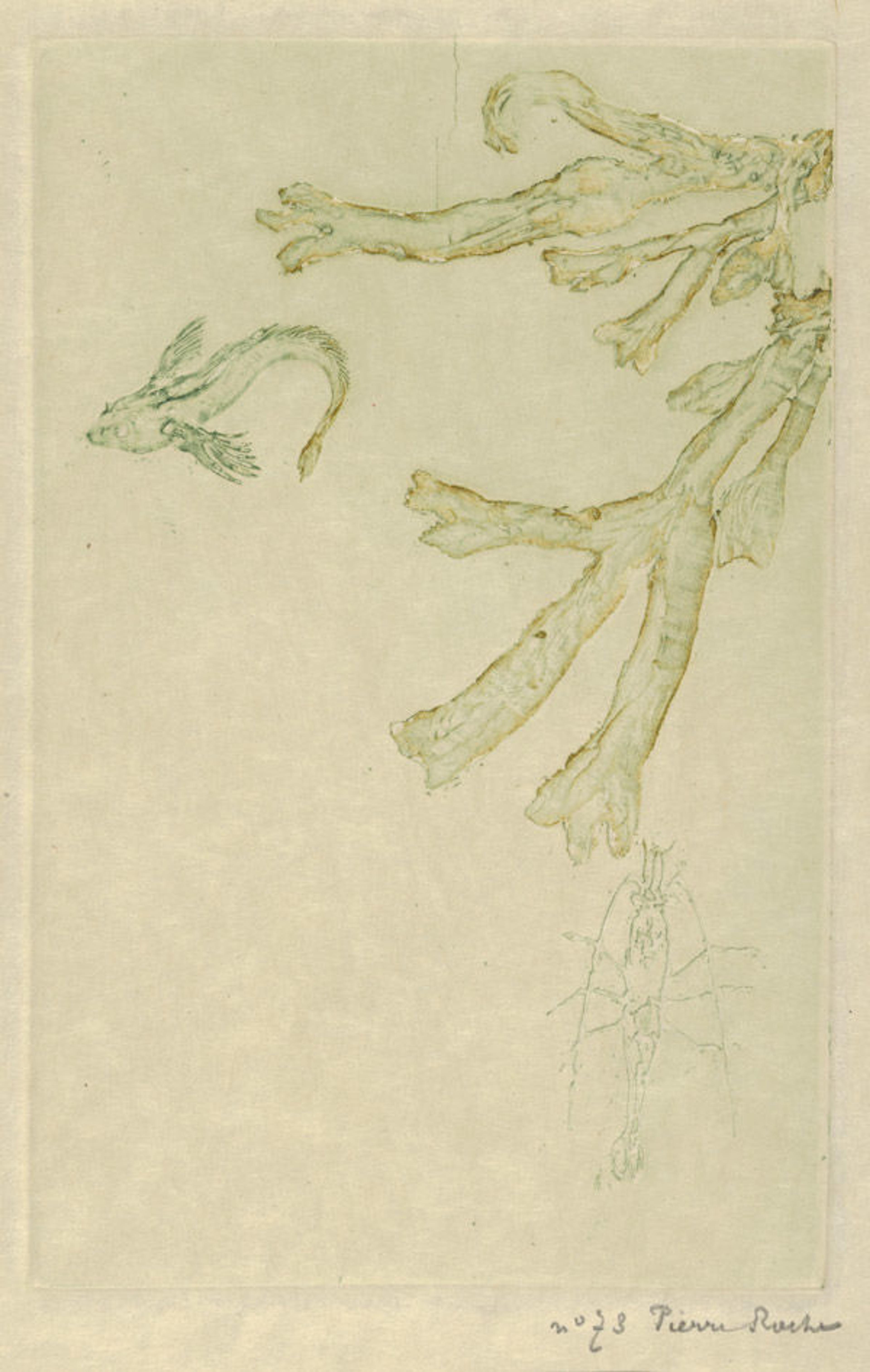
Pierre Roche (pseudonym of Fernand Massignon) (1855–1922); published by André Marty (French, born 1857). Sea Algae (from L'Estampe Originale, Album IV), 1893. French. Gypsograph in two colors; image: 6 3/4 x 4 1/4 in. (17.1 x 10.8 cm). Sheet: 12 3/4 x 8 3/4 in. (32.4 x 22.2 cm). The Metropolitan Museum of Art, New York, Rogers Fund, 1922 (22.82.1-35)
The Department of Drawings and Prints at the Met has a unique, complete set of the prints which includes work from better-known artists such as Gauguin to more obscure printmakers such as Pierre Roche, known for his use of the sculptural print process of gypsography. Although diverse media are represented—including lithography, woodcut, and intaglio prints—the majority of the portfolio was produced using the popular, but technically sophisticated, medium of lithography.

Left: the full print. Right: Each of the Met's prints is numbered "73", indicating their position within the one hundred editions produced. Philippe Charles Blache (French, 1860–1908); published by André Marty (French, born 1857). Twilight (from L'Estampe Originale, Album VII), 1894. French. Lithograph in two colors; Image: 14 3/8 in. x 10 in. (36.5 x 25.4 cm). Sheet: 19 11/16 x 14 15/16 in. (50 x 38 cm). The Metropolitan Museum of Art, New York, Rogers Fund, 1922 (22.82.1-61)
Each of the prints in the Met's copy of L'Estampe Originale is numbered "73" (pictured above, detail at right) to indicate their position within the one hundred editions produced. The fact that all of the prints bear this number likely indicates that the albums come from the holdings of a collector who received the series regularly as a subscriber.
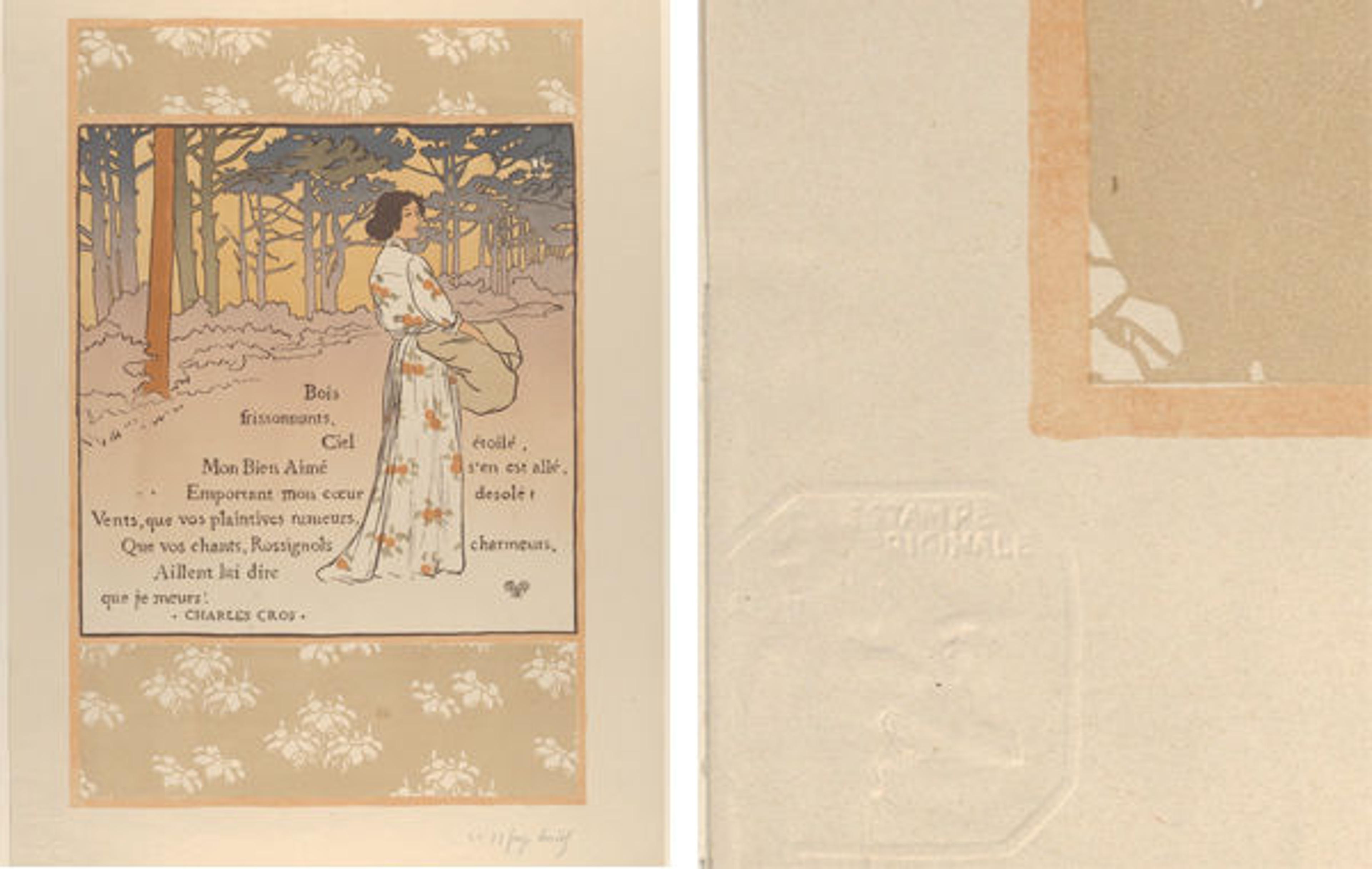
Left: the full print. Right: the blind stamp of L'Estampe Originale. Georges Auriol (French, 1836–1938); published by André Marty (French, born 1857). Trembling Woods (from L'Estampe Originale, Album II), 1893. French. Color lithograph; Image: 19 1/2 x 12 3/4 in. (49.5 x 32.4 cm). Sheet: 22 13/16 x 16 1/8 in. (58 x 41 cm). The Metropolitan Museum of Art, New York, Rogers Fund, 1922 (22.82.1-11)
In addition, each of the prints features the blind stamp of L'Estampe Originale. This embossment was the "signature" of the album and its publisher, and designated the prints as authentic. In the Met's copy, many of the blind stamps have been separated from the prints and affixed to their mounts—perhaps so that the previous owner could fit the larger prints into his portfolios.
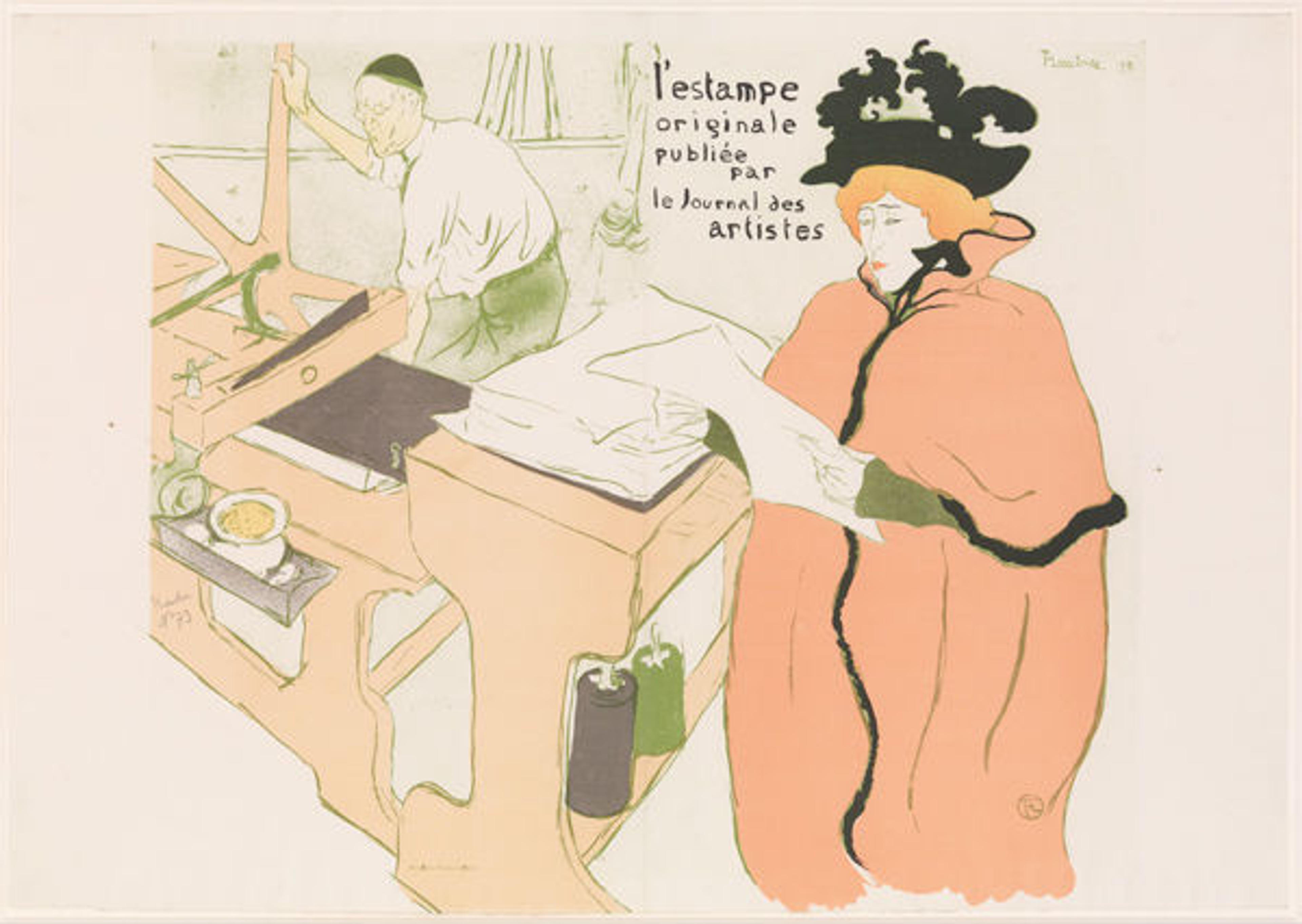
Henri de Toulouse-Lautrec (French, 1864–1901); printed by Edward Ancourt (French, 19th century); published by André Marty (French, born 1857). Cover for L'Estampe Originale, published by the Journal des Artistes (Album I), 1893. French. Lithograph printed in six colors on folded wove paper; only state; Sheet: 23 in. x 32 5/8 in. (58.4 x 82.8 cm). Image: 22 1/4 x 25 11/16 in. (56.5 x 65.2 cm). The Metropolitan Museum of Art, New York, Rogers Fund, 1922 (22.82.1-1)
Beyond its promotion of printmaking as an original and experimental artistic medium, L'Estampe Originale was unique for the level of collaboration it facilitated between artists and professional printers, who often worked behind the scenes and were seen as having a purely technical role in print production. Henri de Toulouse-Lautrec's cover for the first album (pictured above), emphasizes the importance of these figures by showing the expert printer Père Cotelle of Edouard Ancourt's in his workshop with the Parisian cabaret star Jane Avril admiring the product of his effort. (Toulouse-Lautrec worked closely with Cotelle throughout his career.)
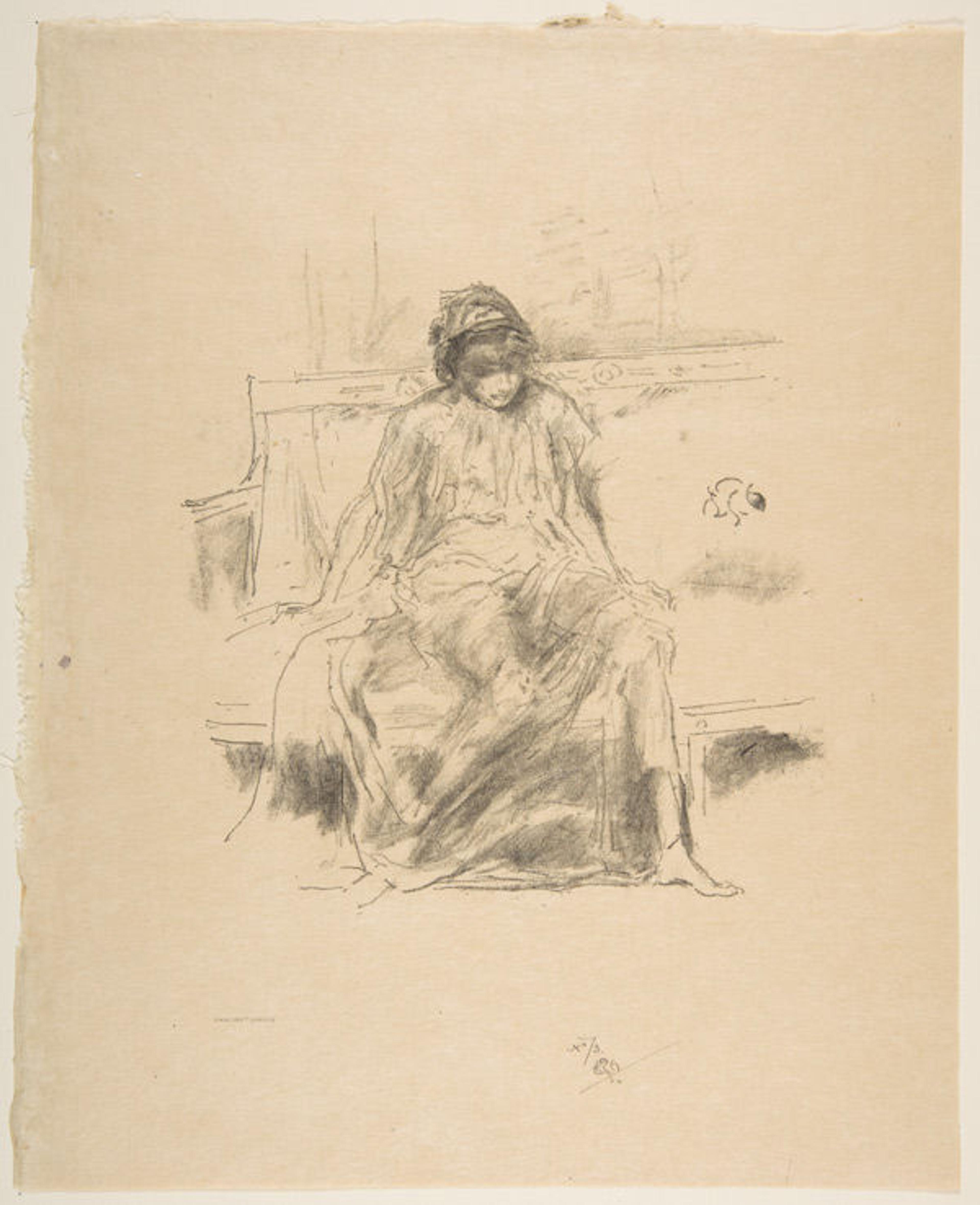
James McNeill Whistler (American, 1834–1903); printed by Thomas Way (British, 1837–1915); published by André Marty (French, born 1857). The Draped Figure Seated (from L'Estampe Originale, Album IV), October–December 1893. French. Transfer lithograph with stumping, drawn on fine-grained transfer paper; only state (Chicago); printed in black ink on heavy weight tan laid Japanese vellum; Image: 7 1/4 x 6 3/8 in. (18.4 x 16.2 cm). Sheet: 11 7/16 x 9 1/4 in. (29.1 x 23.5 cm). The Metropolitan Museum of Art, New York, Rogers Fund, 1922 (22.82.1-40)
Due to the complex technology of a particular printing process, it was, in many instances, necessary for the artists to rely on the services of master printers. These collaborations allowed the albums to include technically innovative work, such as James McNeill Whistler's The Draped Figure, a transfer lithograph printed in black ink. The transfer technique, Whistler's preferred method of working, was pervasive in the last quarter of the nineteenth century as it freed artists from the physical limitations of working directly on the stone and provided an even closer approximation to drawing, particularly as it avoids having to render the image in reverse. Whistler enlisted the assistance of his long-standing printer, Thomas Way, to complete this work, and Marty procured a handmade Japanese paper to print the edition.
Other artists, including Camille Pissarro and Odilon Redon, are known for utilizing the transfer method of lithography, but the technique can be difficult to identify, as the final product can be indistinguishable from prints drawn directly on a stone. The technique was frequently used to facilitate the revision process, which was common in Redon's artistic practice.
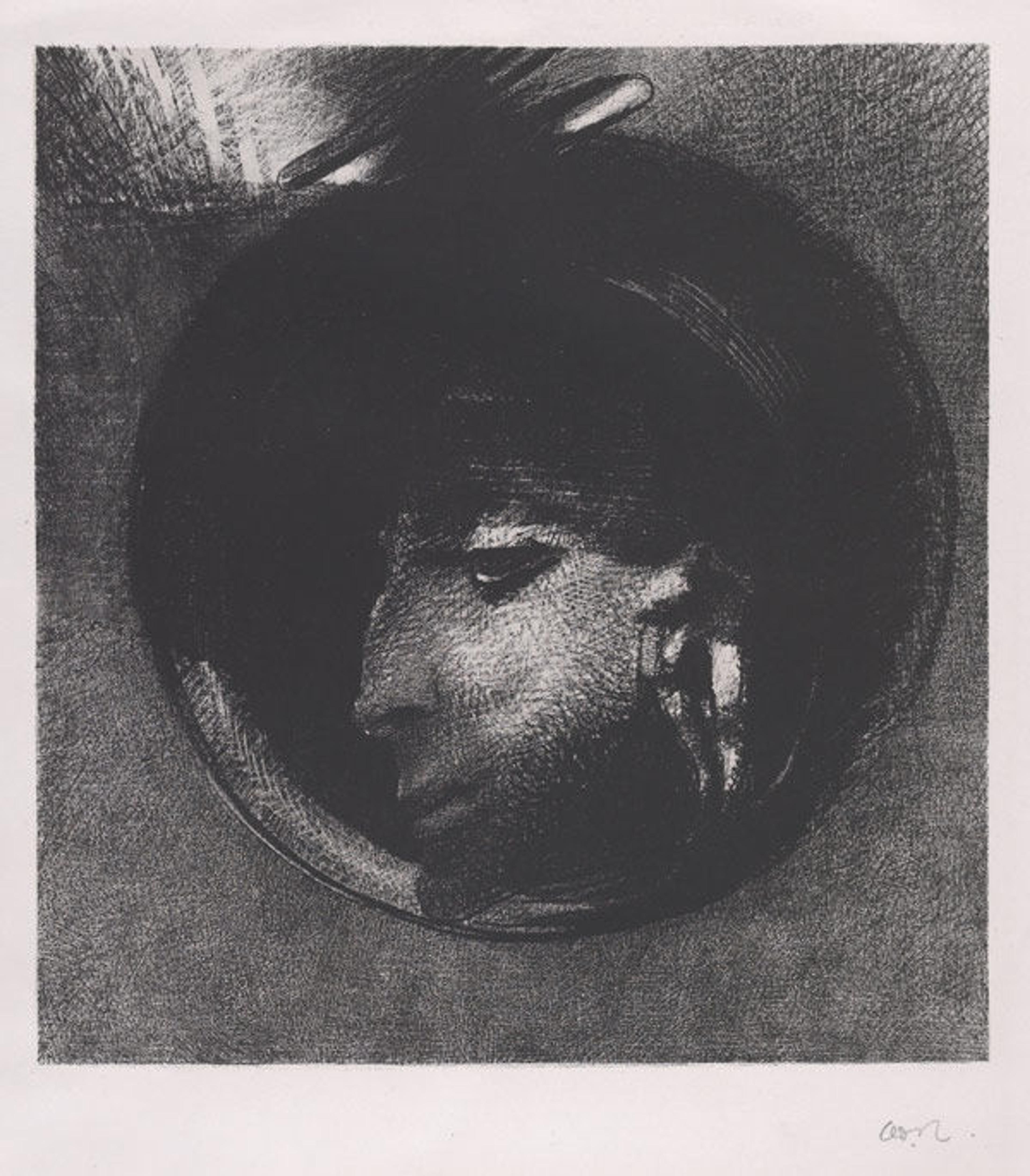
Odilon Redon (French, 1840–1916); printed by Edward Ancourt (French, 19th century); published by André Marty (French, born 1857). Auricular Cell (from L'Estampe Originale, Album II), 1893–94. French. Lithograph on chine collée; Sheet: 21 7/16 x 16 1/8 in. (54.4 x 41 cm). Image: 10 9/16 x 9 13/16 in. (26.8 x 25 cm). The Metropolitan Museum of Art, New York, Rogers Fund, 1922 (22.82.1-18)
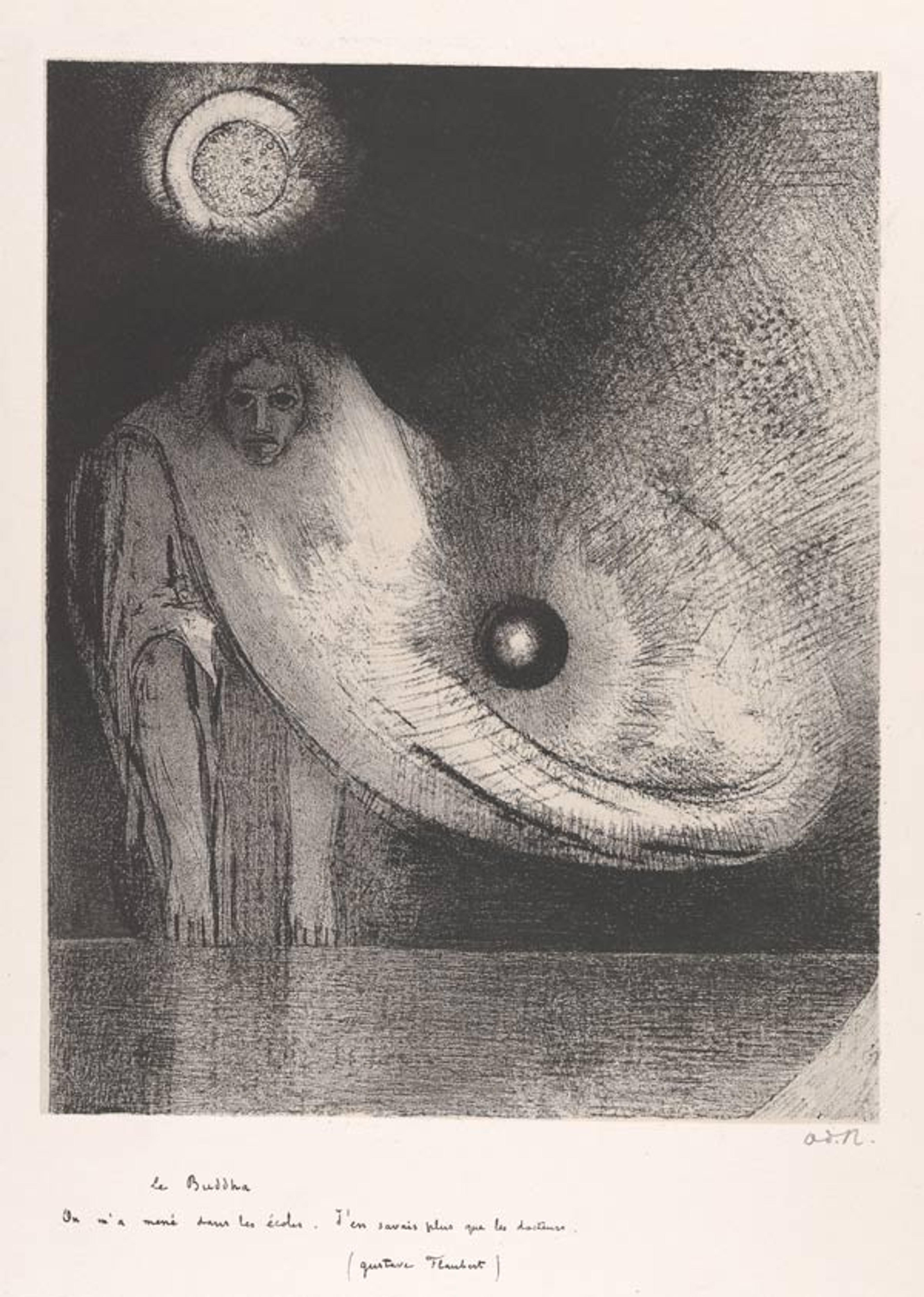
Odilon Redon (French, Bordeaux 1840–1916 Paris); printed by Auguste Clot (French); published by André Marty (French, born 1857). The Buddha (from L'Estampe Originale, Album IX), 1895. French. Lithograph on chine collé; Image: 12 5/16 x 9 3/4 in. (31.3 x 24.8 cm). Sheet: 21 9/16 x 15 3/16 in. (54.7 x 38.5 cm). The Metropolitan Museum of Art, New York, Rogers Fund, 1922 (22.82.1-90)
Both Auricular Cell and Redon's other contribution, Buddha (both pictured above), were made using the chine collé technique. This term refers to the process by which the image is printed onto a sheet of China or other thin paper, which is generally adhered to a thicker paper through a combination of a starch adhesive and pressure during the printing process. China paper was valued by French artists of this time for its tone, lustrous surface, and absorbency of ink. Redon used China papers in his lithographs in a variety of shades including cream, beige, and gray, achieving an analogous effect to what he obtained in his drawing practice where he sometimes used tinted paper to give his drawings a general background hue. In Buddha, for example, we see a light gray background complementing the coolness of the black ink.
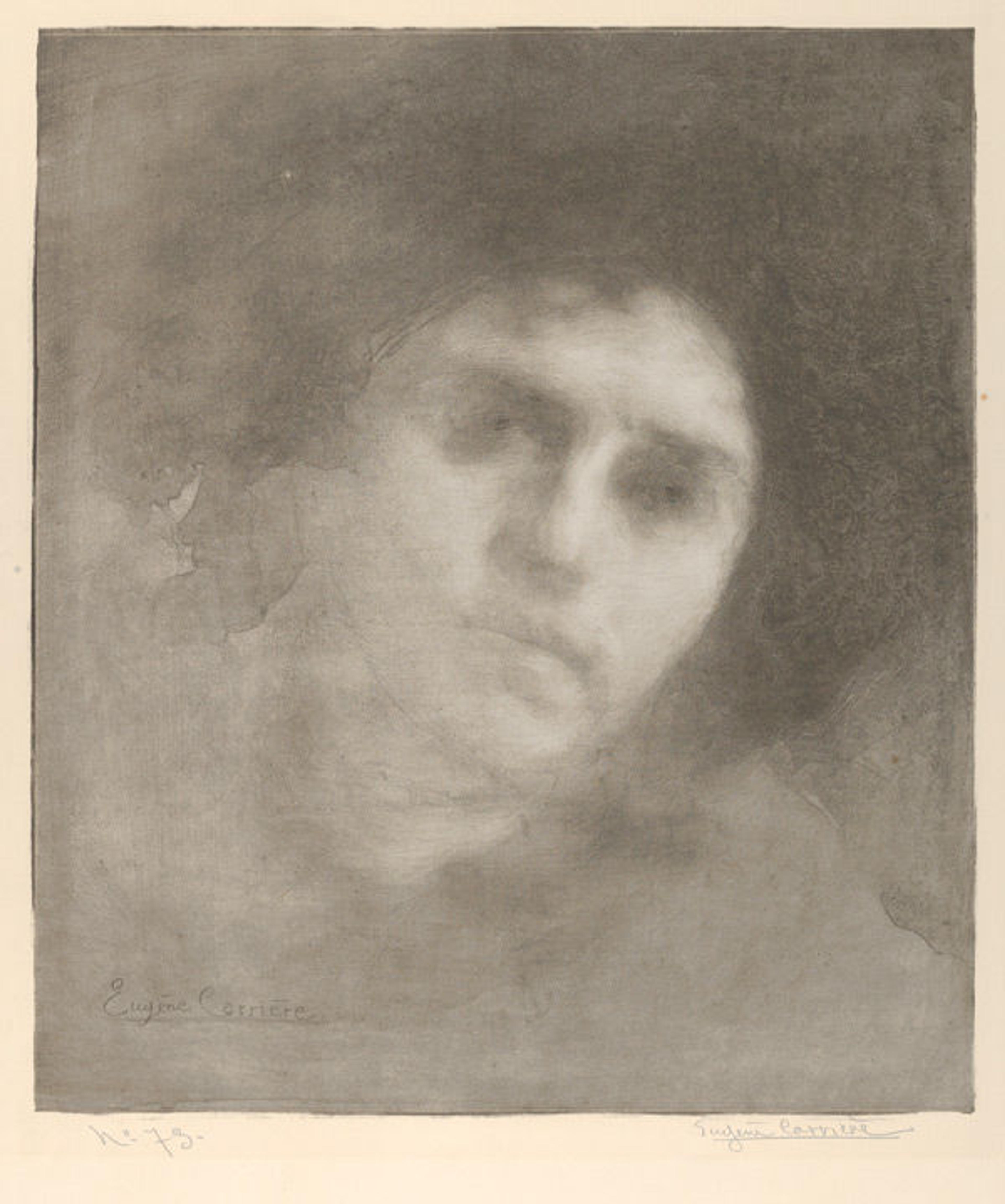
Eugène Carrière (French, 1849–1906); published by André Marty (French, 1857). Mme Eugène Carrière (from L'Estampe Originale, Album IV), 1893. French. Lithograph; only state; Image: 10 5/8 x 13 3/4 in. (27 x 35 cm). Sheet: 13 1/4 x 17 11/16 in. (33.7 x 45 cm). The Metropolitan Museum of Art, New York, Rogers Fund, 1922 (22.82.1-32)
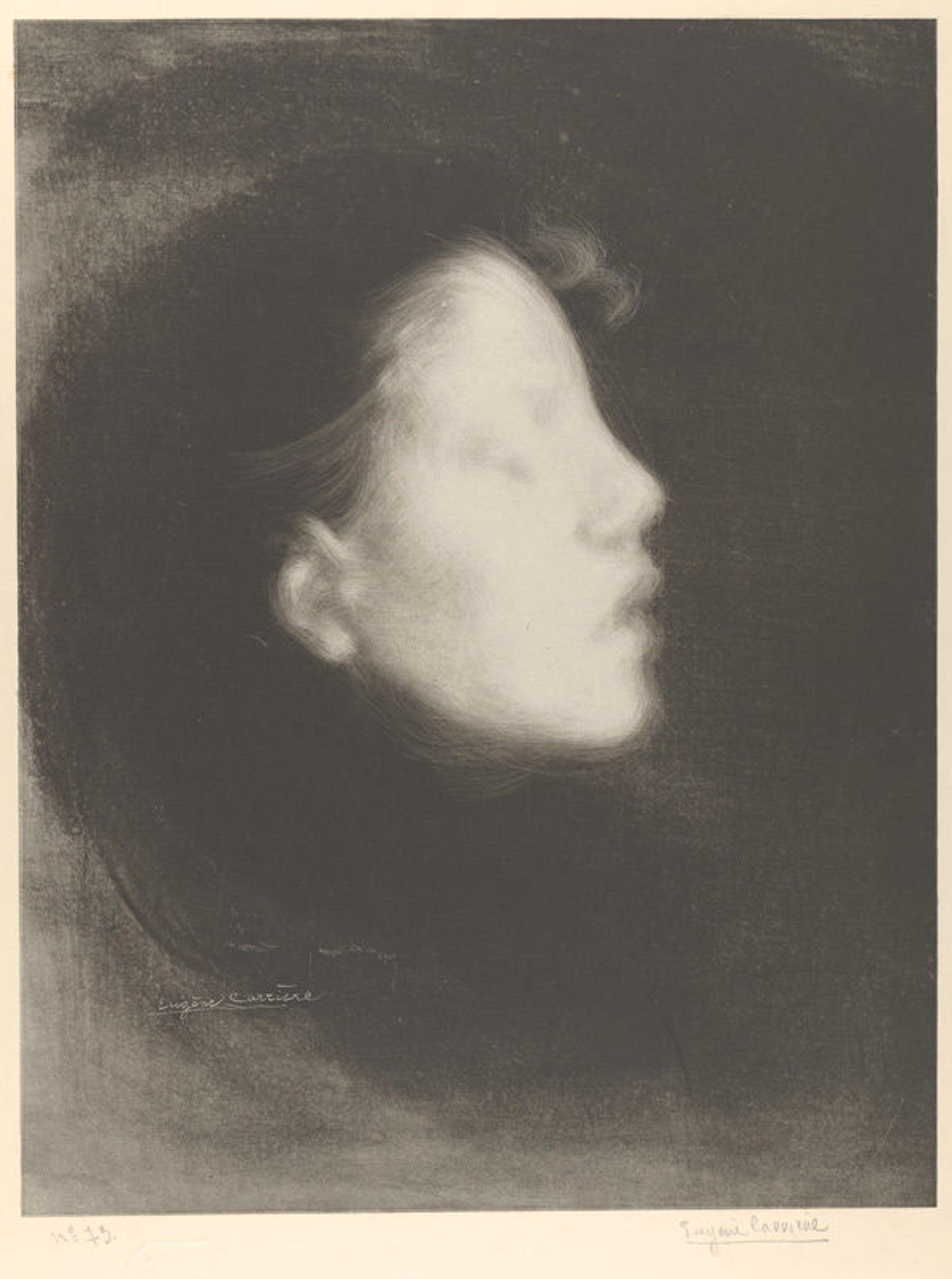
Eugène Carrière (French, 1849–1906); published by André Marty (French, born 1857). Head of a Woman (from L'Estampe Originale, Album IX), 1895. French. Lithograph; Image: 18 5/16 x 14 1/16 in. (46.5 x 35.7 cm). Sheet: 23 5/8 x 16 7/8 in. (60 x 42.9 cm). The Metropolitan Museum of Art, New York, Rogers Fund, 1922 (22.82.1-83)
Finally, Eugene Carrière's lithographs, Mme Eugène Carrière and Head of a Woman are among the most technically sophisticated lithographs in the portfolio. He worked with the assistance of master printer Edouard Duchâtel of Lemercier. Carrière utilized a combination of transfer paper, crayon, ink wash, erasure, and scraping to create his haunting, softly outlined forms.
Although he is not as well-known as some of his peers, Marty's role in the realization of L'Estampe Originale cannot be understated. He brought to the project a unique vision, relationships with a diverse network of artists, fluency with the technical aspects of printmaking, and connections with the top professional workshops of the day. The end result was the most dynamic and eclectic portfolio of an era in which the print achieved a prominent place in French life.
Britany Salsbury
Britany Salsbury is a former research assistant in the Department of Drawings and Prints.
Lisa Conte
Lisa Conte is an assistant conservator in the Department of Paper Conservation.